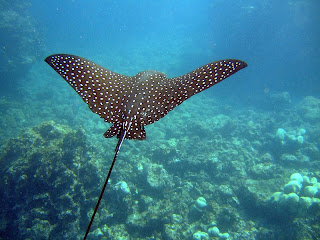On the “Down Island” faculty trip, a group of four set off to explore Eleuthera. Led by Remo, we drove up to Spanish Wells, a group of two islands off the northern tip of the island. A seven dollar ferry ride got us through the narrow channel and over to St. George’s Cay; the hub of Spanish Wells. A Saturday morning brunch beckoned and we slipped into a harbor-side diner called The Anchor Shack.
For the first time in three weeks, I had a hearty, American-style meal. I ordered the Super Breakfast which consisted of scrambled eggs, hash browns, crispy bacon, toast, and the puffiest pancakes I have ever seen. This meal more than made up for the mistake of an order I had at The Beach House restaurant near Governor’s Harbor the night before. Though succulent, the braised duck was smaller than my fist and I consumed it in only two bites.
The community of Spanish Wells, as it was described to us, is predominantly white but thoroughly Bahamian. The original settlers from the west came south from Bermuda during the 1700s. A huge economic boost is that the community has an almost exclusive contract with the restaurant chain Red Lobster. Roughly 80% of all the lobster on the plates of a Red Lobster come from the waters surrounding Spanish Wells and North Eleuthera.
At the Current Cut, the western point on Eleuthera, a swift race of water slices through the porous limestone at close to 10 knots. Starting on the Atlantic side, we jumped off a 8 foot ledge and quickly were whisked downstream towards the Exuma Sound. It took me a few moments to gather myself and adjust to the speed. Focusing in on the bottom, I began seeing shapes sluicing below. Finding my breath, I began a free dive down towards the bottom. Wearing swimming goggles as opposed to a snorkel and mask limited my depth, but I could still make out snapper.
Seemingly as soon as we had jumped in and gotten into the heavy current towards the middle of the channel we had to fight our way back to shore where a back eddy brought us safely into a small sandy beach. Such a quick ride did not whet my appetite for exploration and we scurried out of the water and back up the path. Luckily for us, this extra trip down the current was well worth it.
Upon re-entering the water, we stayed closer to shore. A local fisherman had given up and his hand line was no longer a hazard. By staying closer to the rocks, we found a back eddy. I practiced my free diving, having traded my goggles for a mask. Although leaking, I was able to get into the 25-30 foot range comfortably. At this depth, I needed four arm pulls and coinciding dolphin-kicks to reach the surface.
While working my way down, I spotted a large shape in the distance, flapping majestically. I pulled out of the dive and went horizontally towards the shape. Before swimming up to the surface, I noticed white spots on the back along with an enormous tail barb. Reaching the surface, I started yelling towards my swim partners imploring them to look down. With the horizontal motion of my dive, I had exited the back eddy and starting moving again. With my head below the water, I began counting spotted eagle rays. 6 in one pod and 7 in another. 13 spotted eagle rays in one trip down the Current Cut! What a day.

